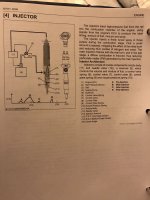I will further research compact tractor DPF temps in the next few days. I am nearly certain DPF in my Kubota
L3560 reaches soot incineration temperature solely through throttle advance to 2,200 engine rpm. In abstract it would seem logical there would be one threshold temperature at which soot would incinerate cleanly and completely within DPF. Perhaps, perhaps not.
Guys, any diesel engine equipped with a DPF uses supplemental fuel during an active regen to burn off the accumulated particulate matter. I don't know why that is even in question. If EGTs are high enough to cook off accumulated PM in the DPF on their own, you'd never see the regen light. This does occur to an extent if you are working the trade hard enough. It is called a passive regen and is 100% natural and requires zero electronic intervention.
Most dealers know very little about the emissions systems on the tractors they sell. Even the service dept often knows very little.
Most tractors (and I believe Kubota is like this) that run common rail injection use a fuel injection event during the exhaust stroke. This sends fuel into the cylinder but without the compression stroke the fuel does not combust. It simply is pushed into the exhaust stream and down towards the DPF. Some DPFs use a separate injector to accomplish this but I do not believe that's the case with Kubota. I have yet to spot a 5th injector in the exhaust system of my 4 cylinder Kubota. It would be more costly. Besides, Kubota themselves mentions the possibility of fuel diluting crankcase oil in the owner's manual. The only way that can occur on an engine that isn't worn out is because of this additional fuel event where unburned fuel enters the combustion chamber but isn't burned.
Furthermore, I think you'll find that even a DPF equipped tractor will also have a DOC. The reason being that a DOC is designed to generate heat. If fuel doesn't combust when it is injected into a hot cylinder on the exhaust stroke, how would it combust in the DPF, which has lower temps than the engine cylinder? It won't, unless that fuel is oxidized in the DOC, which is what it is designed to do.
Some Kubota engines may utilize a DOC, DPF, and an EGR system, which is likely cooled. I believe my MX series tractor has a cooled EGR - I could be wrong, but upon visual inspection that's what it appears to have. There are more emissions targets than "just" particulate matter. A big one is NOx...that's what got VW into so much trouble with their TDI engines. Cooled exhaust end gases recycled into the intake causes fewer NOx emissions to form. None of these lower HP tractors utilize SCR with DEF, so NOx needs to be controlled through EGR.
Less than 26HP is able to meet TierIV Final with no changes...that's why a
B2601 or an
L2501 are still mechanically injected, indirectly, with zero emissions controls on them whatsoever.

